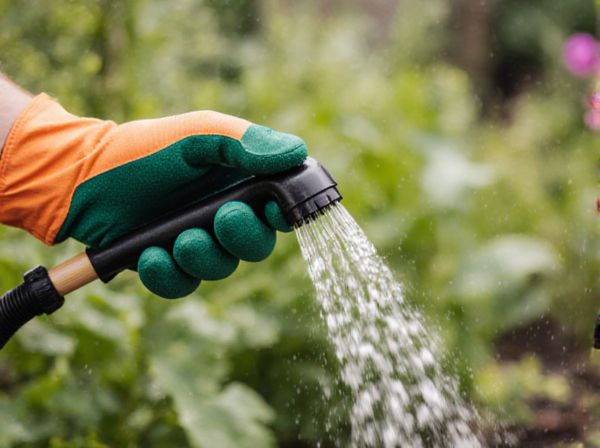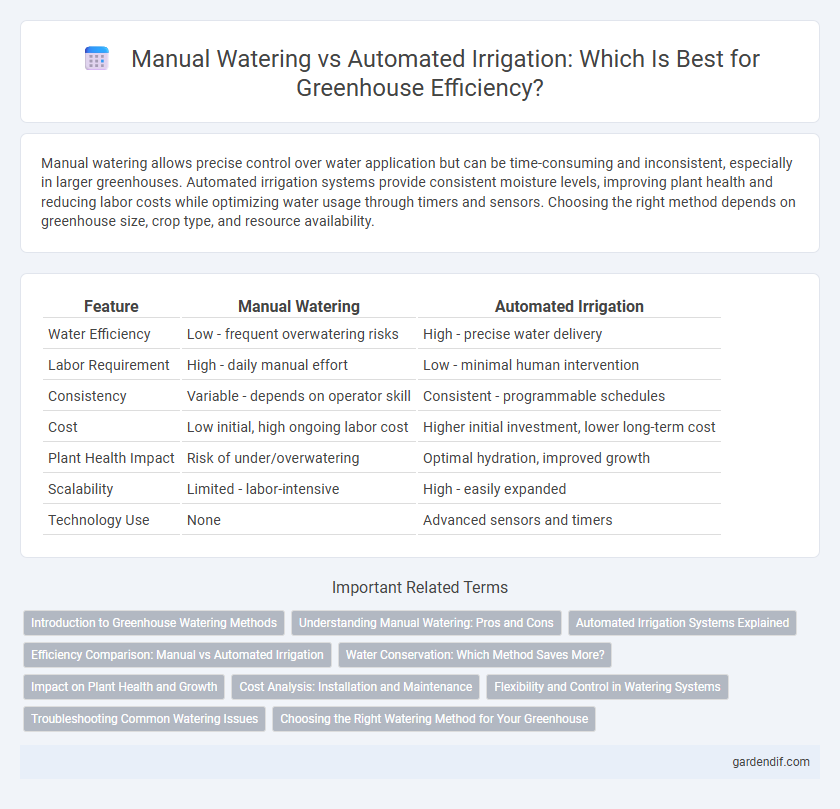
Manual watering vs automated irrigation Illustration
Manual watering allows precise control over water application but can be time-consuming and inconsistent, especially in larger greenhouses. Automated irrigation systems provide consistent moisture levels, improving plant health and reducing labor costs while optimizing water usage through timers and sensors. Choosing the right method depends on greenhouse size, crop type, and resource availability.
Table of Comparison
| Feature | Manual Watering | Automated Irrigation |
|---|---|---|
| Water Efficiency | Low - frequent overwatering risks | High - precise water delivery |
| Labor Requirement | High - daily manual effort | Low - minimal human intervention |
| Consistency | Variable - depends on operator skill | Consistent - programmable schedules |
| Cost | Low initial, high ongoing labor cost | Higher initial investment, lower long-term cost |
| Plant Health Impact | Risk of under/overwatering | Optimal hydration, improved growth |
| Scalability | Limited - labor-intensive | High - easily expanded |
| Technology Use | None | Advanced sensors and timers |
Introduction to Greenhouse Watering Methods
Manual watering in greenhouses involves direct human control, allowing precise moisture adjustment but requiring significant labor and time. Automated irrigation systems use timers, sensors, and drip lines to deliver consistent water levels, enhancing efficiency and promoting optimal plant growth. Selecting the right greenhouse watering method impacts water conservation, crop yield, and overall energy use.
Understanding Manual Watering: Pros and Cons
Manual watering in greenhouses allows precise control over water distribution, reducing the risk of overwatering sensitive plants. However, it is labor-intensive and can lead to inconsistent moisture levels due to human error or varied attention. Understanding these pros and cons helps growers decide when manual watering is suitable for small-scale or high-value crops requiring customized care.
Automated Irrigation Systems Explained
Automated irrigation systems in greenhouses utilize sensors and timers to deliver precise amounts of water directly to plants, optimizing moisture levels and minimizing waste. These systems often integrate with climate control technologies to adjust watering schedules based on real-time temperature, humidity, and soil moisture data. By reducing manual labor and ensuring consistent hydration, automated irrigation enhances plant growth efficiency and promotes sustainable water usage.
Efficiency Comparison: Manual vs Automated Irrigation
Manual watering in greenhouses often leads to inconsistent moisture levels and higher labor costs, reducing overall efficiency. Automated irrigation systems optimize water usage through precise scheduling and sensor technology, enhancing plant growth while conserving resources. Integration of automated irrigation can increase water-use efficiency by up to 30% compared to manual methods.
Water Conservation: Which Method Saves More?
Automated irrigation systems in greenhouses use sensors and timers to deliver precise amounts of water, significantly reducing water waste compared to manual watering. Studies show automated methods can save up to 30-50% more water by targeting plant roots and minimizing evaporation. Manual watering often results in inconsistent application, leading to overwatering or underwatering and higher overall water consumption.
Impact on Plant Health and Growth
Manual watering offers precise control over water application, allowing adjustments based on plant needs, which can prevent overwatering and root diseases, thereby promoting healthier growth. Automated irrigation systems provide consistent and timely watering, reducing stress caused by irregular moisture levels and enhancing uniform growth rates. Choosing the appropriate method directly influences plant vitality, with automated systems favoring large-scale uniformity and manual watering benefiting species with specific hydration requirements.
Cost Analysis: Installation and Maintenance
Manual watering in greenhouses requires low initial costs but incurs higher long-term labor expenses and inconsistent water application, affecting plant growth and resource efficiency. Automated irrigation systems involve higher installation costs, often ranging from $1,000 to $5,000 depending on scale and technology, yet reduce labor costs and improve water use efficiency through precise scheduling and delivery. Maintenance expenses for automated systems include periodic equipment checks and potential repairs, typically lower in cumulative cost compared to ongoing manual watering labor over several growing seasons.
Flexibility and Control in Watering Systems
Manual watering provides precise control over water application, allowing growers to adjust watering frequency and volume based on daily plant needs and environmental conditions. Automated irrigation systems offer consistent delivery of water with programmable schedules, ensuring uniform moisture levels and reducing labor. Flexibility is enhanced in manual methods for spot treatments, while automation excels in maintaining optimal growth conditions at scale.
Troubleshooting Common Watering Issues
Manual watering in greenhouses often leads to inconsistent moisture levels, causing stress to plants due to overwatering or underwatering. Automated irrigation systems help maintain precise water delivery, but common troubleshooting issues include clogged emitters, uneven pressure distribution, and timer malfunctions. Regular inspection and calibration of irrigation components ensure optimal water efficiency and healthy plant growth.
Choosing the Right Watering Method for Your Greenhouse
Choosing the right watering method for your greenhouse depends on factors such as crop type, greenhouse size, and water availability. Manual watering offers precise control and flexibility for small-scale setups, while automated irrigation systems enhance efficiency by delivering consistent moisture and reducing labor. Incorporating soil moisture sensors with automated systems optimizes water use, promoting healthy plant growth and resource conservation.
Manual watering vs automated irrigation Infographic

 gardendif.com
gardendif.com